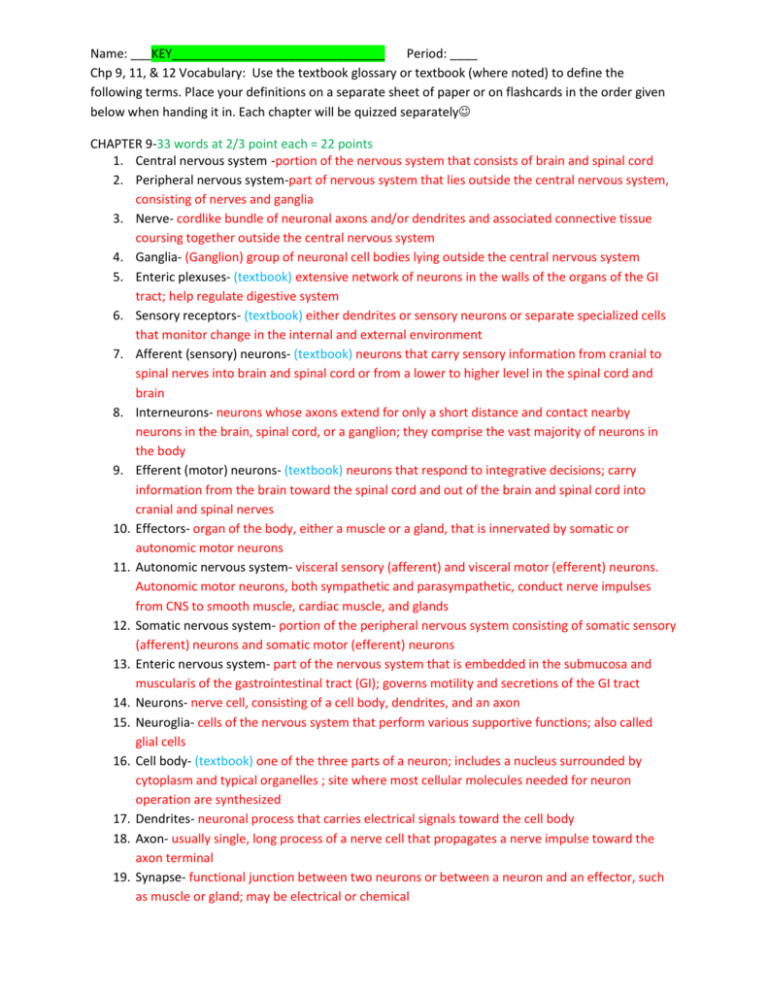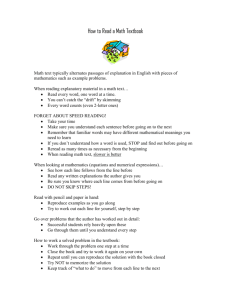Name: ___KEY_______________________________ Period
advertisement

Name: ___KEY_______________________________ Period: ____ Chp 9, 11, & 12 Vocabulary: Use the textbook glossary or textbook (where noted) to define the following terms. Place your definitions on a separate sheet of paper or on flashcards in the order given below when handing it in. Each chapter will be quizzed separately CHAPTER 9-33 words at 2/3 point each = 22 points 1. Central nervous system -portion of the nervous system that consists of brain and spinal cord 2. Peripheral nervous system-part of nervous system that lies outside the central nervous system, consisting of nerves and ganglia 3. Nerve- cordlike bundle of neuronal axons and/or dendrites and associated connective tissue coursing together outside the central nervous system 4. Ganglia- (Ganglion) group of neuronal cell bodies lying outside the central nervous system 5. Enteric plexuses- (textbook) extensive network of neurons in the walls of the organs of the GI tract; help regulate digestive system 6. Sensory receptors- (textbook) either dendrites or sensory neurons or separate specialized cells that monitor change in the internal and external environment 7. Afferent (sensory) neurons- (textbook) neurons that carry sensory information from cranial to spinal nerves into brain and spinal cord or from a lower to higher level in the spinal cord and brain 8. Interneurons- neurons whose axons extend for only a short distance and contact nearby neurons in the brain, spinal cord, or a ganglion; they comprise the vast majority of neurons in the body 9. Efferent (motor) neurons- (textbook) neurons that respond to integrative decisions; carry information from the brain toward the spinal cord and out of the brain and spinal cord into cranial and spinal nerves 10. Effectors- organ of the body, either a muscle or a gland, that is innervated by somatic or autonomic motor neurons 11. Autonomic nervous system- visceral sensory (afferent) and visceral motor (efferent) neurons. Autonomic motor neurons, both sympathetic and parasympathetic, conduct nerve impulses from CNS to smooth muscle, cardiac muscle, and glands 12. Somatic nervous system- portion of the peripheral nervous system consisting of somatic sensory (afferent) neurons and somatic motor (efferent) neurons 13. Enteric nervous system- part of the nervous system that is embedded in the submucosa and muscularis of the gastrointestinal tract (GI); governs motility and secretions of the GI tract 14. Neurons- nerve cell, consisting of a cell body, dendrites, and an axon 15. Neuroglia- cells of the nervous system that perform various supportive functions; also called glial cells 16. Cell body- (textbook) one of the three parts of a neuron; includes a nucleus surrounded by cytoplasm and typical organelles ; site where most cellular molecules needed for neuron operation are synthesized 17. Dendrites- neuronal process that carries electrical signals toward the cell body 18. Axon- usually single, long process of a nerve cell that propagates a nerve impulse toward the axon terminal 19. Synapse- functional junction between two neurons or between a neuron and an effector, such as muscle or gland; may be electrical or chemical 20. Neurotransmitters- one of a variety of molecules within axon terminals that are released into the synaptic cleft in response to a nerve impulse, and that change the membrane potential of the postsynaptic neuron 21. Myelin sheath- multilayered lipid and protein covering, formed by Schwann cells and oligodendrocytes, around axons of many peripheral and central nervous system neurons 22. Membrane potential- (textbook) difference in the amount of electrical charge on the inside compared to the outside of the plasma membrane 23. Polarized- (textbook) cell that has membrane potential 24. Resting membrane potential- voltage difference between the inside and outside of a cell membrane when the cell is not responding to a stimulus; in many neurons and muscle fibers it is -70mV to -90mV, with the inside of the cell negative relative to the outside 25. Threshold- (textbook) critical level of depolarization caused by a stimulus to the membrane that leads to an action potential 26. Depolarizing phase- (depolarization) reduction of voltage across a plasma membrane; expressed as a change toward less negative (more positive) voltages on the interior surface of the plasma membrane 27. Repolarizing phase- (repolarization) restoration of a resting membrane potential after depolarization 28. Refractory period- time period during which an excitable cell (neuron or muscle fiber) cannot respond to a stimulus that is usually adequate to evoke an action potential 29. Synaptic transmission- (textbook) series of events through which synapses neurons communicate with other neurons or with effectors 30. Presynaptic neuron- neuron that propagates nerve impulses toward a synapse 31. Postsynaptic neuron- nerve cell that is activated by release of a neurotransmitter from another neuron and carries nerve impulses away from the synapse 32. Synaptic cleft- narrow gap at a chemical synapse that separates the axon terminal of one neuron from another neuron or muscle fiber (cell) and across which a neurotransmitter diffuses to affect the postsynaptic cell 33. Neurotransmitter receptors- (textbook) receiver site of neurotransmitters that have diffused across the synaptic cleft to postsynaptic neurons CHAPTER 11- 15 words at 2/3 point each = 10 points 1. Autonomic sensory neuronsrves- (textbook) neurons associated with sensory receptors that monitor internal conditions, such as blood CO2 level 2. Autonomic motor neurons- (textbook) regulate ongoing activities in their effector tissues, which are cardiac muscle, smooth muscle, and glands, by both excitation and inhibition 3. Preganglionic neuron- first autonomic motor neuron in an autonomic pathway, with its cell body and dendrites in the brain or spinal cord and its myelinated axon ending at autonomic ganglion, where it synapses with a postganglion neuron 4. Postganglionic neuron- second autonomic motor neuron in an autonomic pathway, having its cell body and dendrites located in an autonomic ganglion and its unmyelinated axon ending at cardiac muscle, smooth muscle, or a gland 5. Sympathetic division- one of the two subdivisions of the ANS, having cell bodies or preganglionic neurons in the lateral gray columns of the thoracic segment and the first two or three lumbar segments of the spinal cord; primarily concerned with processes involving the expenditure of energy 6. Parasympathetic division- one of the two subdivisions of the ANS, having cell bodies or preganglionic neurons in nuclei in the brain stem and in the lateral gray horn of the sacral portion of the spinal cord; primarily concerned with activities that conserve and restore body energy 7. Dual innervation- (textbook) receiving of impulses from both sympathetic and parasympathetic neurons 8. Sympathetic trunk ganglia- cluster of cell bodies of sympathetic postganglionic neurons lateral to the vertebral column, close to the body of a vertebra. These ganglia extend inferiorly through the neck, thorax, and abdomen to the coccyx on both sides of the vertebral column and are connected to one another to form a chain on each side of the vertebral column 9. Prevertebral ganglia- cluster of cell bodies of postganglionic sympathetic neurons anterior to the spinal column and close to large abdominal arteries 10. Adrenal medulla- (textbook) inner part of adrenal gland 11. Epinephrine- hormone secreted by the adrenal medulla that produces actions similar to those that result from sympathetic simulation 12. Terminal ganglia- (textbook) ganglia located close to or actually within the wall of their innervated organ 13. Neurotransmitters- DUPLICATE OMIT..OOPS!!! 14. “Fight-or flight” response- effects produced upon stimulation of the sympathetic division of the ANS 15. “Rest-and-digest” activities- (textbook) parasympathetic division enhances these activities; support body functions that conserve and restore body energy during time of rest and recovery CHAPTER 12- 28 words at ½ point each = 14 points 1. Special senses- (textbook) the five senses; smell, taste, vision, hearing, and balance 2. General senses- (textbook) somatic senses and visceral senses 3. Somatic senses- (textbook) tactile sensations: touch, pressure, vibration, thermal sensations: warm and cold, pain sensations, and proprioceptive sensations: joint and muscle position sense and movement of limbs and head 4. Visceral senses- (textbook) provide information about conditions within body fluids and internal organs 5. Sensation- state of awareness of external or internal conditions of the body 6. Perceptions- (textbook) conscious sensations integrated in cerebral cortex 7. Adaptation- adjustment of the pupil of the eye to changes in light intensity OR property by which a sensory neuron relays a decreased frequency of action potentials from a receptor 8. Tactile sensations- (textbook) sensations of touch, pressure, vibration, itch, and tickle 9. Itch- (textbook) sensation resulting from stimulation of free nerve endings by certain chemicals, such as bradykinin, often result of local inflammatory response 10. Tickle- (textbook) sensations associated with free nerve endings and lamellated corpuscles; typically arises only when someone else touches you, not when you touch yourself 11. Thermoreceptors- sensory receptor that detects change in temperature 12. Nociceptors- free (naked) nerve ending that detects pain stimuli 13. Proprioceptors- receptor located in muscles, tendons, joints, or the internal ear (muscle spindles, tendon organs, joint kinesthetic receptors, and hair cells of the vestibular apparatus) that provide information about body position and movements 14. Kinesthesia- perception of the extent and direction of movement of body parts; this sense is possible due to nerve impulses generated by proprioceptors 15. Olfaction- (textbook) sense of smell 16. Olfactory receptors- bipolar neuron with its cell body lying between supporting cells located in the mucous membrane lining the superior portion of each nasal cavity; transduces odor into neural signals 17. Gustation- (textbook) sense of taste 18. Gustatory receptor cells- (textbook) one of three cells of the taste buds; have a life span of about 10 days; separate receptor cells that do not have an axon but rather synapse with dendrites 19. Retina- deep coat of the posterior portion of the eyeball consisting of nervous tissue (where the process of vision begins) and a pigmented layer of epithelial cells that contact the choroid 20. Rods- one of two types of photoreceptor in the retina of the eye; specialized for vision in dim light 21. Cones- type of photoreceptor in the retina that is specialized for highly acute color vision in bright light 22. Binocular vision- (textbook) both eyes focus on a single object or set of objects; allows for depth perception and 3-D perception 23. Convergence- synaptic arrangement in which the synaptic end bulbs of several presynaptic neurons terminate on one postsynaptic neuron OR medial movement of the two eyeballs so that both are directed toward a near object being viewed in order to produce a single image 24. Photopigment- substance that can absorb light and undergo structural changes that can lead to the development of a receptor potential 25. Rhodopsin- photopigment in the rods of the retina, consisting of glycoprotein called opsin and a derivative of vitamin A called retinal 26. Equilibrium- (textbook) balance 27. Static equilibrium- maintenance of posture in response to changes in the orientation of the body, mainly the head, relative to the ground 28. Dynamic equilibrium- maintenance of body position, mainly in the head, in response to sudden movement such as rotation








